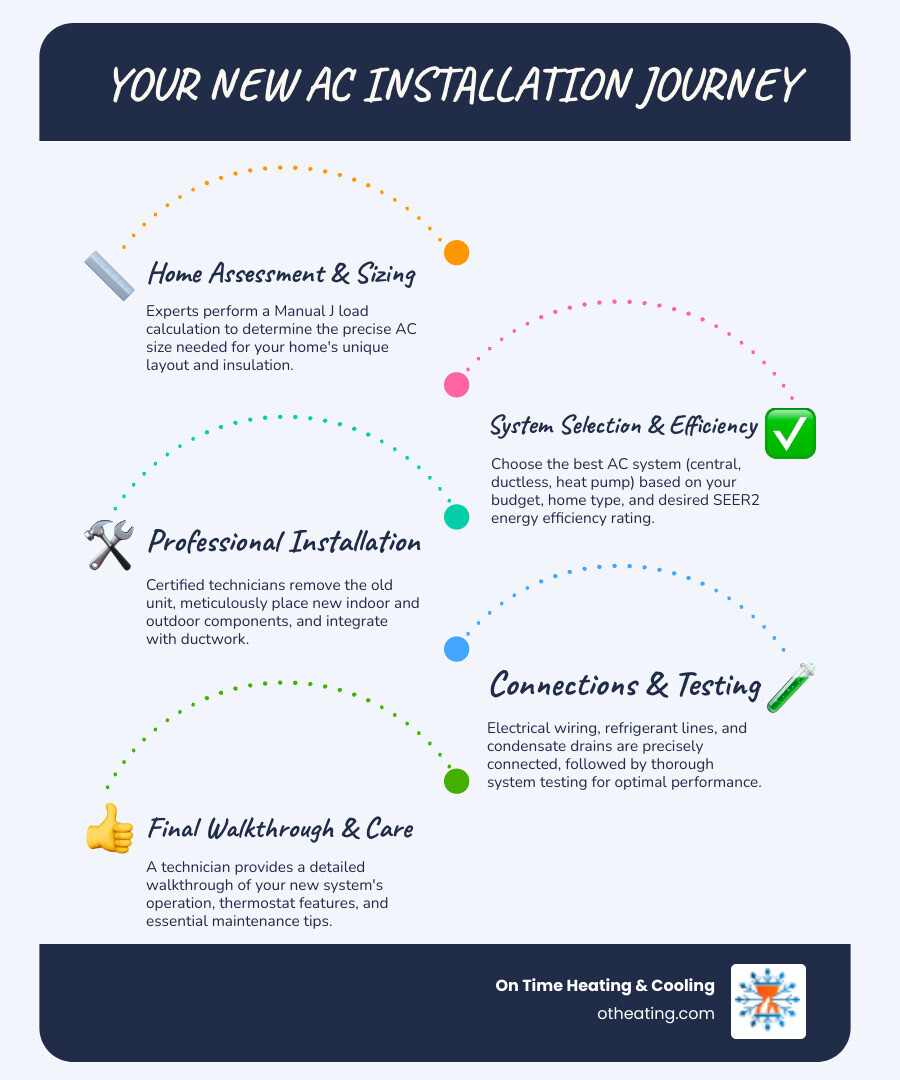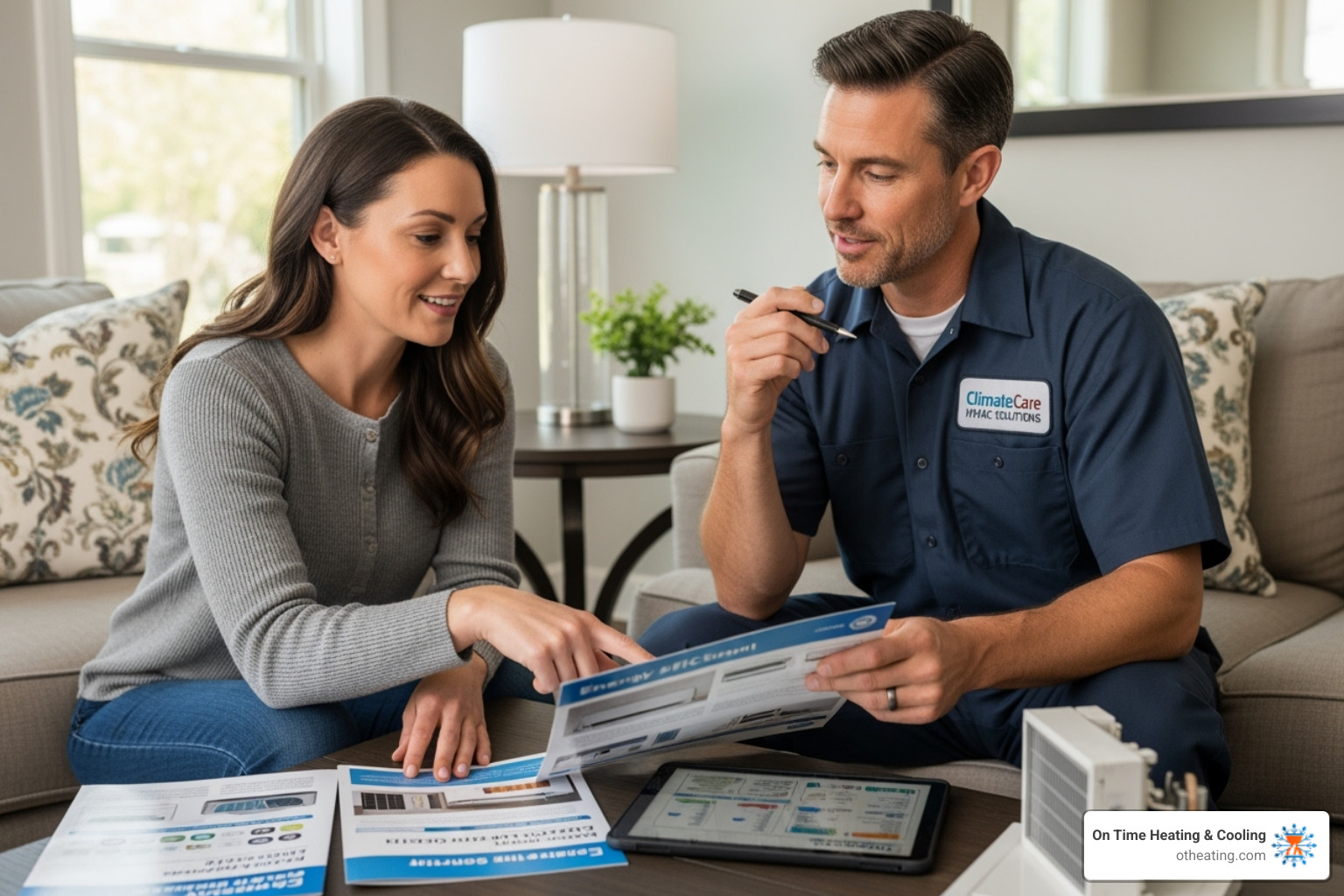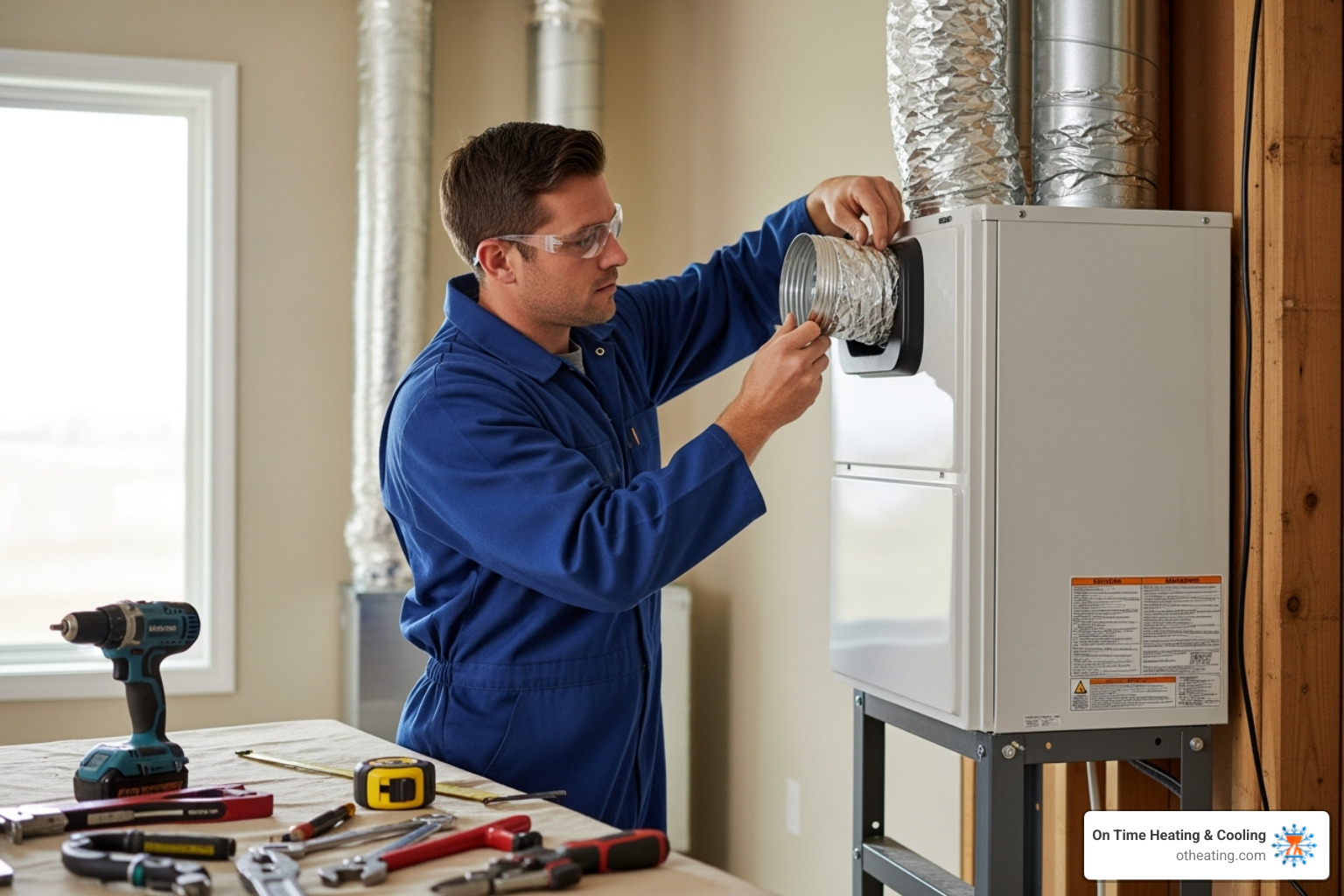
Seamless New AC Installation: Get Your Home Chilling Right
Why New AC Installation Matters for Your Home's Comfort
A new ac installation is a major home improvement that improves comfort, lowers energy bills, and increases property value. A professionally installed system provides reliable cooling for 15-20 years and maximizes energy efficiency.
Key considerations for a new AC installation include:
- System Types: Central air is best for homes with ductwork, while ductless mini-splits are ideal for homes without ducts or for cooling specific rooms.
- Proper Sizing: A Manual J load calculation ensures the correct system size. An improperly sized unit wastes energy and reduces comfort.
- Energy Efficiency: High SEER2 ratings and ENERGY STAR® certification can save up to 36% on annual cooling costs.
- Professional Installation: Licensed technicians guarantee safe connections and optimal performance.
- Timeline: Most installations take 4-8 hours, depending on the system and home layout.
Your HVAC system is a critical long-term choice, lasting 15 to 20 years with proper maintenance. Modern high-efficiency units provide superior comfort and can significantly reduce your utility bills compared to older models.
Installation typically costs between $3,500 to $8,500 for most homes. Federal tax credits and utility rebates can help offset these costs, and the long-term energy savings make it a worthwhile investment.

Pre-Installation Essentials: Choosing the Perfect AC System
Choosing the right air conditioning system will impact your daily comfort for the next 15 to 20 years. It's about finding the perfect match for your home, lifestyle, and budget, not just picking the biggest or cheapest option. Getting the sizing, type, and efficiency right is the key to a comfortable home.

Signs It's Time for a New Unit
Before choosing a new system, you need to know if it's time for a new ac installation. Look for these signs:
- Frequent repairs: If repair bills are piling up, you're likely spending money on a failing system.
- Skyrocketing energy bills: Rising cooling costs without increased usage indicate your old unit is losing efficiency. Modern systems can cut cooling costs by up to 36%.
- Age: Central ACs last about 15 years, and ductless systems up to 20. Once your unit hits the 15-year mark, it's living on borrowed time.
- Poor cooling performance: Hot spots, uneven temperatures, or a system that can't keep up with the thermostat all point to an aging unit.
- Strange noises: Persistent rattling, squealing, or banging often means internal components are failing.
- Excessive moisture: Moisture around your indoor unit can signal drainage issues or refrigerant leaks that need professional attention.
If these issues sound familiar, it's time to consider the benefits of a new ac installation.
Choosing the Right AC System for Your Home
Once you've decided to upgrade, you need to choose the right type of system for your home.
- Central air conditioners are ideal for homes with existing ductwork, providing consistent, whole-home cooling.
- Ductless mini-splits are perfect for homes without ducts. They use an outdoor unit connected to individual indoor units, allowing for flexible, zoned cooling.
- Heat pumps provide energy-efficient heating and cooling in one system. They transfer heat rather than generating it, making them an excellent choice for moderate climates.
| System Type | Best For | Key Features | Considerations |
|---|---|---|---|
| Central Air Conditioners | Whole-home cooling in homes with existing ductwork | Distributes cool air through ducts; Consistent temperatures; Integrates with furnace | Requires existing ductwork; Less individual room control; Higher cost for homes without ducts |
| Ductless Mini-Splits | Homes without ductwork; Room additions; Zone control | Individual indoor units; Independent temperature control; Highly efficient | More expensive per zone for whole-home coverage; Visible indoor units; Requires refrigerant line installation |
| Heat Pumps | Year-round heating and cooling in moderate climates | Both heats and cools; Highly energy-efficient; Uses electricity | Performance drops in extreme cold; Higher upfront investment |
Modern systems can also integrate with advanced filters, humidifiers, and UV lights to improve indoor air quality. We offer specialized AC Installation Services in Waukesha, WI and comprehensive HVAC Installation Services in Brookfield, WI custom to local needs.
The Critical Role of Sizing, Placement, and Efficiency (SEER2)
Getting the system type right is just the start. Sizing, placement, and efficiency are what truly optimize performance.
Proper sizing is critical. An undersized unit will struggle to cool your home, while an oversized one is even worse. As experts explain when asked Is it bad to have an HVAC unit that is too big for the house?, an oversized system short-cycles, turning on and off without removing humidity properly. This wastes energy and causes premature wear.
That's why we perform a detailed Manual J load calculation. This precise engineering calculation considers your home's unique features, from square footage and insulation to window placement and local climate, to ensure correct sizing.
SEER2 ratings and ENERGY STAR® certification are your guides to long-term savings. SEER2 (Seasonal Energy Efficiency Ratio 2) measures efficiency; higher numbers mean lower operating costs. Today's high-efficiency models can reach 21 SEER2 or more.
Unit placement affects performance and lifespan. The outdoor unit needs proper airflow, while indoor units require strategic placement for optimal air distribution.
The performance impact of getting these details right is immense. Proper sizing, placement, and efficiency lead to consistent comfort, lower energy bills, and a longer-lasting system. We Ensure AC Installation Meets Home's Needs from day one, because getting these fundamentals right is what makes a great installation.
The Professional New AC Installation Process: A Step-by-Step Guide
Once you've chosen your system, the professional new ac installation begins. This precise process requires skill and experience to ensure your family's long-term comfort. From our arrival to the final test, we focus on delivering an installation that will keep you cool for decades.

Phase 1: Home Assessment and Load Calculation
Installation day begins with a final home assessment. Our inspection covers your electrical panel's capacity, access points for equipment, and any unique home features affecting installation. The Manual J load calculation is the foundation for a perfectly performing system, based on your home's square footage, insulation, windows, and more.
For central air, we conduct a thorough ductwork assessment, checking for leaks, sizing issues, or poor insulation that could waste energy. This approach is part of our commitment to following the Steps to Follow for Quality AC Installation.
Phase 2: System Setup and Ductwork Considerations
This phase is where your old system makes way for modern cooling technology.
- Old unit removal is a technical process. The old refrigerant must be safely recovered by an EPA-certified technician, as releasing it is illegal and harmful. We also protect your home with drop cloths.
- Outdoor unit placement is crucial. We find a level, stable spot with good airflow, away from potential obstructions.
- Indoor unit installation involves securely mounting the air handler or evaporator coil and connecting it to your ductwork. We use new refrigerant lines to prevent contamination and ensure efficiency.
- Ductwork modification is performed if we find issues during our assessment. This may involve sealing leaks, resizing sections, or adding insulation to improve performance.
- Duct sealing is the final touch. We seal every joint and connection to prevent conditioned air from escaping, which significantly improves efficiency.
Phase 3: Final Connections, Testing, and Walkthrough
This is where all the careful planning and work come together.
- Electrical wiring is done by licensed experts according to safety codes, connecting the units to your panel and installing a new service disconnect.
- Refrigerant line connection involves brazing copper pipes for a leak-proof seal. We use nitrogen to prevent internal oxidation and perform thorough leak tests.
- The condensate drain is installed with the proper slope and a safety overflow switch to prevent water damage.
- System testing is our final check. We vacuum the lines to remove contaminants, charge the system with the precise amount of refrigerant, and run it for at least 20 minutes while monitoring pressures and temperatures to ensure perfect operation.
- Thermostat setup includes installing and calibrating your new thermostat, ensuring it communicates correctly with the system.
- The homeowner walkthrough is our favorite part. We explain how your new system works, answer all your questions, and share maintenance tips so you feel completely confident with your new ac installation.
Understanding the Costs & Savings of a New AC
A new ac installation is a significant expense, but it's also a smart investment in your home. A new system can pay for itself over time through energy savings, rebates, and improved comfort.

What Factors Influence New AC Installation Costs?
Every new ac installation is unique, so costs vary. Several key factors shape the final price:
- System type: Central air is cost-effective with existing ducts, while ductless systems are great for homes without them. Heat pumps cost more upfront but provide both heating and cooling.
- Unit size: The unit must be properly sized for your home. An incorrectly sized unit costs more to run and performs poorly.
- SEER2 rating: Higher SEER2-rated units have a higher upfront cost but deliver significant long-term energy savings.
- Ductwork condition: The condition of your existing ductwork can affect the cost. Any necessary repairs or modifications will be discussed upfront.
- Home complexity: Complex installations in multi-story homes or tight spaces may increase labor costs.
We believe in transparency, which is why we cover everything in our guide on AC Installation: What Homeowners Need to Know.
Opening up Savings: Rebates, Tax Credits, and Long-Term Efficiency
Look beyond the upfront cost to see how your new ac installation saves you money.
- Federal tax credits for high-efficiency HVAC equipment can significantly reduce your net cost.
- Local utility rebates are often available for upgrading to efficient equipment. We stay current on these programs and help you apply.
- Manufacturer promotions and special financing offers can make your purchase more affordable.
- Long-term energy savings are the biggest benefit. Upgrading an old system can cut your cooling bills by up to 36% annually for the 15-20 year lifespan of the unit.
- Renting vs buying is another consideration. We can discuss the pros and cons of each to help you decide what's best for your financial situation.
Why Professional Installation is Non-Negotiable
While DIY new ac installation videos may seem tempting, it's a project where cutting corners is dangerous and costly. AC installation involves high-voltage electrical work, handling of controlled refrigerants, and complex calculations that determine efficiency. It is not a DIY job.

Professional installation ensures the job is done right, protecting your warranty, ensuring safety, and maximizing performance. Attempting it yourself can lead to expensive problems and safety hazards.
The Dangers of DIY AC Installation
The risks of a DIY installation are real and significant:
- Electrical Hazards: Incorrect wiring is a fire or electrocution risk. AC units require dedicated circuits installed to code.
- Illegal Refrigerant Handling: Handling refrigerant without EPA certification is illegal, dangerous to your health, and harmful to the environment.
- Voided Warranty: Manufacturers require professional installation to validate the equipment warranty. A DIY job means you pay for all future repairs.
- Poor Performance & Reduced Lifespan: Improper installation leads to poor cooling, higher energy bills, code violations, and a shorter lifespan for your unit.
Learn more about the Top Benefits of AC Installation Over DIY before considering this route.
Finding a Qualified and Reputable AC Installer
Choosing the right contractor is as important as the system itself. Here's what to look for:
- Licensing and Insurance: Always verify a contractor's credentials. This protects you from liability.
- Certifications: NATE (North American Technician Excellence) certification indicates a technician's proven expertise.
- Customer Reviews: Check reviews on multiple platforms to gauge a company's reputation and service quality.
- Written Estimates: Get a clear, itemized written estimate to avoid hidden fees and surprise charges.
- Local Experience: Choose a contractor with local experience who understands regional building codes and climate challenges.
At On Time Heating & Cooling, our reputation is built on punctuality and reliability. We respect your time and are committed to professional service. For guidance on Choosing Professional AC Installation Services or to explore our AC Installation Services in Menomonee Falls, WI, we're here to help.
Frequently Asked Questions about New AC Installation
We get a lot of questions about new ac installation. Here are answers to some of the most common ones.
How long does a typical AC installation take?
A typical replacement takes 4 to 8 hours. A straightforward swap of a similar central air system usually fits this timeframe. However, complex jobs, like installing a new duct system or a multi-zone ductless system, can take one to two days. Factors like home layout and electrical upgrades can also affect the timeline. We provide a realistic schedule during your consultation.
What maintenance does a new AC unit require?
Even a new unit needs regular maintenance to perform efficiently and last for its full lifespan. Key tasks include:
- Annual Tune-Ups: Schedule a professional tune-up each spring to clean coils, check refrigerant, and inspect all components.
- Filter Changes: Change your filter every 1-3 months, or more often if you have pets or allergies.
- Clear Outdoor Unit: Keep the area around your outdoor unit clear of leaves, grass, and debris. Ensure at least two feet of clearance on all sides.
- Check Condensate Drain: Periodically check the drain line to prevent clogs and potential water damage.
What is the average lifespan of a new air conditioner?
A professionally installed and maintained AC unit is a long-term investment in your home's comfort.
- Central air conditioners typically last about 15 years.
- Ductless systems can last up to 20 years.
Regular maintenance is the key to maximizing the lifespan of either system. Considering its 15-20 year lifespan, a new ac installation is a sound investment that provides comfort and energy savings for years to come.
Conclusion
A new ac installation is more than an equipment upgrade; it's an investment in your family's comfort and well-being. The rewards include consistent temperatures, lower energy bills, cleaner air, and increased property value. Most importantly, you gain peace of mind from a professional installation done right the first time.
We've covered the importance of proper sizing with Manual J calculations, the savings from high SEER2 ratings, and why professional installation is non-negotiable for safety and performance.
At On Time Heating & Cooling, we are your local experts committed to punctuality and your comfort. We combine reliable, old-school customer service with modern installation techniques and high-efficiency equipment. Our strong team environment ensures your new ac installation is a smooth, efficient process from start to finish. We take pride in explaining everything clearly and ensuring you feel confident with your new system.
We serve Menomonee Falls, Brookfield, Delafield, Pewaukee, Sussex, Waukesha, New Berlin, Oconomowoc, Lannon, Mukwonago, Hartland, Wales, Berlin, Nashotah, Richfield, Cedarburg, North Prairie, Dousman, Merton, Elm Grove, Hales Corners, Muskego, Germantown, Jackson, Mequon, Big Bend, Wind Lake, Slinger, and Colgate, WI.
Your comfort is our mission. Ready to take the next step? For expert AC replacement in Brookfield, WI, and surrounding areas, contact us today!

%202%20(1).svg)
.svg)

.svg)
.svg)
.svg)

.svg)